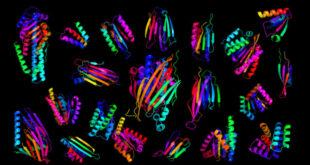An international team of researchers from Brazil, the United States and Sweden has found that polyphenols found in berries of the açaí palm (Euterpe oleracea) can reduce malaria parasites in the blood of infected mice and prolong their survival.
Açaí palms (Euterpe oleracea) in Summit Park, Panama. Image credit: Dick Culbert / CC BY 2.0.
Caused by parasites of the genus Plasmodium and transmitted by mosquitoes, malaria is historically one of the major parasitic diseases to affect human populations.
The World Health Organization estimates that more than 200 million cases of the disease occurred in 2017. Worse yet, Plasmodium parasites are developing resistance to many antimalarial drugs.
Natural extracts have played a major role in the discovery of antimalarial compounds, as antimalarial drugs such as quinine and artemisinin are derived from plants widely used in the traditional medicine.
Biodiversity-rich regions like the Amazon are valuable sources of plants with potential antimalarial activity.
Among Brazilian Amazon plants, the açaí is both one of the most consumed fruits. Local communities in Brazil use it to treat malaria-related symptoms such as fever.
In recent years, the high antioxidant content of this grape-like fruit has boosted its popularity outside of Brazil and has caused some to consider it a ‘superfood.’ This antioxidant activity arises mainly from polyphenols — compounds that have been linked to health benefits such as weight loss, cardiovascular disease prevention and decreased cancer risk.
Ferreira et al demonstrated the antimalarial potential of açaí polyphenols in vitro and in vivo. Image credit: Ferreira et al, doi: 10.1021/acsomega.9b02127.
The research team led by Texas AM University’s Dr. Susanne Mertens-Talcott and University of Campinas’ Dr. Fabio Costa wanted to determine if açaí extracts could treat malaria in mice, and if so, whether polyphenols in the berries were responsible for the therapeutic effect.
The scientists extracted polyphenols from açaí berries and then treated malaria parasite cultures growing in a Petri dish with the extracts.
They found that a class of polyphenols called nonanthocyanin phenolics inhibited the growth of both chloroquine-resistant and -sensitive parasites.
Then, the researchers orally administered açaí polyphenols to malaria-infected mice.
The treatment reduced the parasitic load in the mice’s blood by 89.4% compared with untreated mice.
All of the mice given polyphenols survived for more than 15 days, whereas none of the untreated mice lived.
“The açaí extracts appeared to interfere with the parasites’ protein homeostasis, or the balance between protein production and degradation,” the study authors said.
The findings were published in the journal ACS Omega.
_____
Letícia T. Ferreira et al. 2019. Chemical Genomic Profiling Unveils the in Vitro and in Vivo Antiplasmodial Mechanism of Açaí (Euterpe oleracea Mart.) Polyphenols. ACS Omega 4 (13): 15628-15635; doi: 10.1021/acsomega.9b02127
 #Bizwhiznetwork.com Innovation ΛI |Technology News
#Bizwhiznetwork.com Innovation ΛI |Technology News





